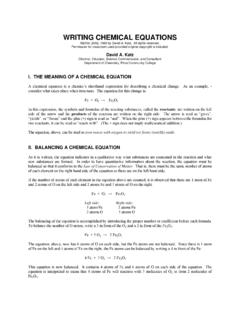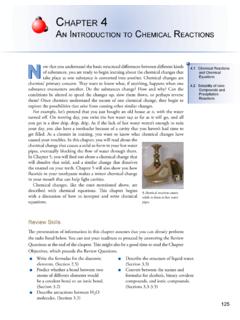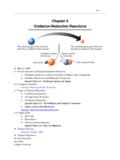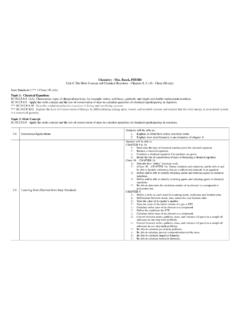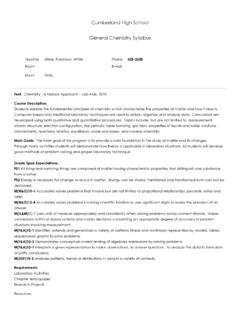Transcription of Chemical Reaction Stoichiometry (CRS): A Tutorial
1 Chemical Reaction Stoichiometry (CRS):A Tutorial Ronald W. MissenDepartment of Chemical Engineering and Applied ChemistryUniversity of TorontoToronto, Ontario Canada M5S 3E5andWilliam R. SmithSchool of Engineering, and Department of Mathematics and StatisticsUniversity of GuelphGuelph, Ontario Canada N1G 2W1 Downloaded from web site URL 1998 R. W. Missen and W. R. Smith, all rights reservedCRS,c 1998 R. W. Missen & W. R. Smith, all rights reservediContents1 Introduction12 What is Chemical Reaction Stoichiometry (CRS)? A definition .. Why is CRS important? .. The central problem of CRS.
2 Balancing Chemical reactions .. Preliminary examples of sets of Chemical equations .. Mathematical equivalent of the central problem of CRS .. Historical Background ..83 From Atom-balance equations to Chemical Equations94 Universal, Systematic Method to Obtain Chemical Equa-tions (MRM)135 Implementations of Hand Calculation .. Computer Algebra Software .. 196 Java Applet Getting Started .. Capabilities .. Help File for JSTOICH .. 257 Outline of Applications of Applications in Chemical Equilibrium .. of Chemical equilibrium.
3 Data ( 0i) from equilibrium constant data( G0j,Kaj) .. Applications in Chemical Kinetics .. of independent steps (Fs) in a Reaction network ofFsimplied by a Reaction mechanismusing CRS .. Stoichiometric Restrictions .. From Chemical equations to Atom-balance equations .. 33 CRS,c 1998 R. W. Missen & W. R. Smith, all rights reservedii8 Exercises34 Nomenclature40 Literature Cited41 Acknowledgements45 CRS,c 1998 R. W. Missen & W. R. Smith, all rights reserved11 IntroductionChemical Reaction Stoichiometry (CRS) is a branch of Chemical stoichiome-try dealing with the constraints, in the form of Chemical equations , placedon changes in the composition of a closed reacting system by the require-ment for conservation of the amount of each atomic species and of the totalcharge.
4 This simple conservation concept has far-reaching consequences forall of chemistry and Chemical engineering, including Reaction kinetics andreactor design, Reaction equilibrium, and Reaction book-keeping in Chemical equations are to be used to express this concept, it is impor-tant to have a universal, systematic method for generating a proper set foranysystem under consideration. However, many methods currently in use,particularly in introductory teaching, do not properly or fully exploit theconcept, and may give incomplete or misleading results; their scope is verylimited, rendering them obsolete for general understand the role played by CRS, we believe that it is desirableto study it in its own right, uncontaminated by implications stemmingfrom such things as Reaction networks, Reaction mechanisms, and , CRS does not contribute to intrinsic predictive information forkinetics or equilibrium, but only provides constraints on any universal, systematic method we describe in this paper and imple-ment on the web site is not new, and has been described extensively elsewhere(Smith and Missen, 1979; 1982, 1991).
5 As an aid to the efficiency of learningabout CRS, it builds on a student s existing knowledge of very basic material(in addition to the concept of atomic conservation): the representation of achemical species by a molecular formula, and the solution of sets of linear al-gebraic equations . Since it uses elementary matrix operations for the latter,we call it thematrix reduction method(MRM); we remark that it employsonly such basic matrix manipulations as those involved in the solution ofsets of linear equations , and essentially uses a matrix only as a convenienttabular way of organizing the calculations.
6 MRM can be implemented byhand-calculation, and, for convenience in complex cases, can be programmedfor implementation by computer. A new Java applet for the latter is intro-duced in this Tutorial , and is accessible for use interactively on the web sitelocated at spite of a long history of the use of an algebraic method for the simplestsituation in CRS, that of balancing a single specified Reaction (method ofBottomley, 1878), there appears to be considerable resistance on the partCRS,c 1998 R. W. Missen & W. R. Smith, all rights reserved2of instructors to the use of such a method in CRS.
7 The reasons given are:(1) that it emphasizes mathematics and not chemistry, (2) that, as a result,students don t learn about chemistry in the form of oxidation numbers and half- reactions , and (3) that, if implemented by computer, it uses a sledgehammer to crack the egg of (in many cases) a relatively simpleproblem. In response, it can be argued that (1) students learn preciselywhat part of chemistry is involved in CRS (see also Olson, 1997), (2) otherparts are extraneous to, and unnecessary for, CRS, and (3) use of computersand computer software is simply a matter of convenience to eliminate tediumfor large-scale systems, but is not a overcome our suspicion of resistance on the part of many instructors,we are taking advantage of two advances in technology which may act asa catalyst to achieve adoption of MRM.
8 Ease of accessibility afforded by aweb site on a global basis, and the interactive capability of a Java applet forimplementation of the purpose of this Tutorial is to provide a treatment of CRS as the basisfor MRM. The Tutorial first describes the nature and importance of CRS, andprovides some historical background. It then shows the genesis of chemicalequations from algebraic atom-balance equations . This is followed by a sim-ple algorithm for the procedure used in MRM. Implementation of MRM byvarious means, including use of the Java applet, is illustrated with new Java applet itself, JSTOICH, is also described, with sections on Getting Started , Capabilities , and Help.
9 JSTOICH is intended to beboth a teaching/learning tool and a user tool, and can be used interactivelyon the web site. Exercises are provided for the reader to gain experience inusing MRM, particularly by implementation with JSTOICH. They also ex-plore further aspects of CRS, including some examples of apparent confusionin the What is Chemical Reaction Stoichiometry (CRS)? A definitionWe definechemical stoichiometryas the constraints placed on the composi-tion of a closed system by the requirement for conservation of the amountof each atomic species and of electronic charge. These constraints take theCRS,c 1998 R.
10 W. Missen & W. R. Smith, all rights reserved3form of linear conservation equations , which may be expressed in the formof either linear algebraic atom- and charge-balance equations , or Reaction Stoichiometry (CRS) is concerned with the lat-ter. The Java applet on the web site constructs Chemical equations using asinput only the molecular formulas of the species stated as being present inthe term Chemical Reaction includes not only a Chemical transforma-tion, but also a phase change such as the vaporization of water. We are thusconcerned with the Stoichiometry of both single- and multiphase Why is CRS important?
